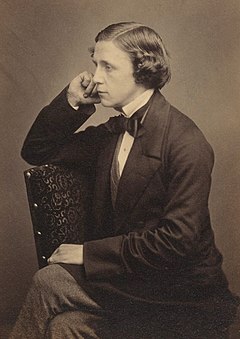From Wikipedia, the free encyclopedia
|
Charles Lutwidge Dodgson |

|
| Born |
27 January 1832
Daresbury, Cheshire,
England |
| Died |
14 January 1898 (aged 65)
Guildford, Surrey, England |
|
Pen name |
Lewis Carroll |
|
Occupation |
Author, mathematician, Anglicanclergyman, photographer |
|
Nationality |
British |
|
Genres |
Children's literature, fantasy
literature, poetry, literary
nonsense |
| Notablework(s) |
Alice's Adventures in Wonderland,Through
the Looking-Glass, "The
Hunting of the Snark", "Jabberwocky" |
Charles Lutwidge Dodgson(pronounced /ˈdɒdsən/, DOD-sən;
27 January 1832 – 14 January 1898), better known by the pseudonym Lewis
Carroll(/ˈkærəl/, KAH-rəl),
was an Englishauthor, mathematician, logician,Anglican deacon and
a photographer.
His most famous writings are Alice's
Adventures in Wonderland and
its sequel Through
the Looking-Glass, as well as the poems "The
Hunting of the Snark" and "Jabberwocky",
all examples of the genre of literary
nonsense. He is noted for his facility at word
play, logic, and fantasy, and there are societies dedicated to the
enjoyment and promotion of his works and the investigation of his life in many
parts of the world, including the United
Kingdom,Japan,
the United
States, and New
Zealand.
Antecedents
Dodgson's family was predominantly northern English, with Irish connections.
Conservative and High
Church Anglican, most of
Dodgson's ancestors were army officers or Church of England clergymen. His
great-grandfather, also Charles Dodgson, had risen through the ranks of the
church to become a bishop. His grandfather, another Charles, had been an army
captain, killed in action in 1803 when his two sons were hardly more than
babies. His mother's name was Frances Jane Lutwidge.[1]
The elder of these sons — yet another Charles — was Carroll's father. He
reverted to the other family business and took holy
orders. He went to Rugby
School, and thence to Christ
Church, Oxford. He was mathematically gifted and won a double first
degree, which could have been the prelude to a brilliant academic career.
Instead he married his first cousin in 1827 and became a country parson.[2]
Young Charles' father was an active and highly conservative clergyman of the
Anglican church who involved himself, sometimes influentially, in the intense
religious disputes that were dividing the Anglican church. He was High Church,
inclining to Anglo-Catholicism,
an admirer of Newman and
the Tractarian
movement, and did his best to instill such views in his children. Young
Charles, however, was to develop an ambiguous relationship with his father's
values and with the Anglican church as a whole.[3]
Dodgson was born in the little parsonage of Daresbury near
Warrington, Cheshire, the oldest boy but already the third child of the
four-and-a-half-year-old marriage. Eight more were to follow. When Charles was
11, his father was given the living of Croft-on-Tees in
North Yorkshire, and the whole family moved to the spacious Rectory. This
remained their home for the next twenty-five years.
Education
Rugby
During his early youth, young Dodgson was educated at home. His "reading
lists" preserved in the family testify to a precocious intellect: at the age
of seven the child was reading The
Pilgrim's Progress. He also suffered from a stammer —
a condition shared by his siblings — that often influenced his social life
throughout his years. At twelve he was sent away to a small private school at
nearby Richmond (now
part ofRichmond
School), where he appears to have been happy and settled. But in 1846,
young Dodgson moved on to Rugby
School, where he was evidently less happy, for as he wrote some years
after leaving the place:
I cannot say ... that any earthly considerations would induce me to go
through my three years again ... I can honestly say that if I could have been
... secure from annoyance at night, the hardships of the daily life would have
been comparative trifles to bear.[4]
Scholastically, though, he excelled with apparent ease. "I have not had a more
promising boy his age since I came to Rugby", observed R.B. Mayor, the
Mathematics master.[4]



























































